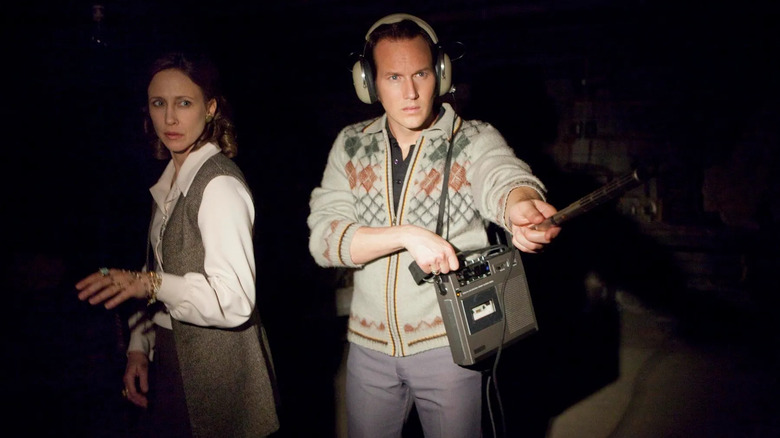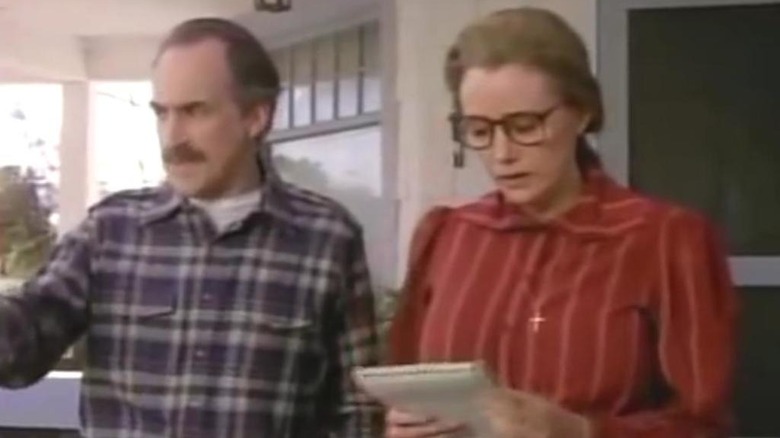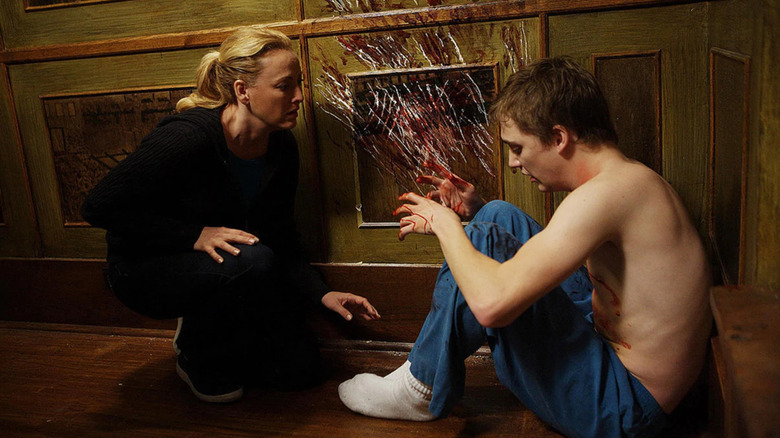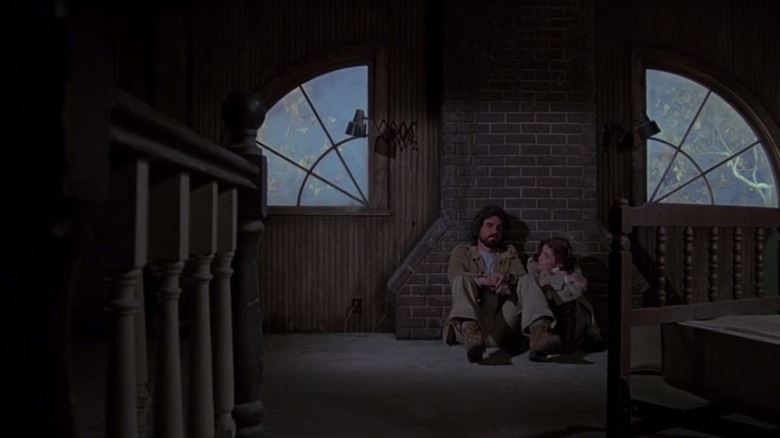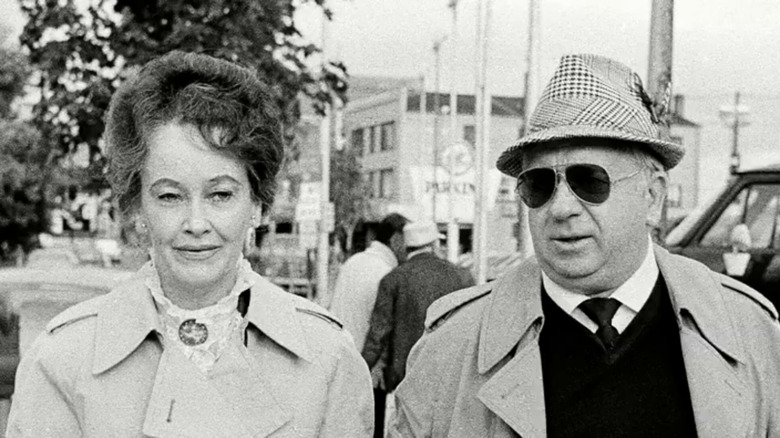Beyond The Conjuring: Horror Movies That Don't (But Could) Exist Within The Warren Universe
It took nearly 20 years to make "The Conjuring," a "based on a true story" film about the supposed hauntings of the Perron family in Harrisville, Rhode Island. For over 14 years, producer Tony DeRosa-Grund went from studio to studio trying to make the film happen, but it wasn't until writers Chad and Carey W. Hayes updated the script and shifted the perspective from the Perron family to paranormal investigators Ed and Lorraine Warren that there was movement on the picture. The duo interviewed Lorraine Warren to ensure authenticity, and the new script sparked a massive bidding war. The Hayes brothers had cracked the code — the secret of what would become a massive franchise lay with the Warrens.
Before the era of televised paranormal investigators like Zak Bagans of "Ghost Adventures" or "Kindred Spirits" stars Amy Bruni and Adam Berry, there were Ed and Lorraine Warren. Ed was a professed demonologist, while Lorraine claimed to be a clairvoyant. Together, the two founded the New England Society for Psychic Research and were involved in many of the most well-known reported hauntings in modern U.S. history. While The Conjuring Universe introduced the Warrens to a new generation, they were staple figures for decades, and many of their investigations had been given the movie treatment before James Wan would direct Patrick Wilson and Vera Farmiga as the famous couple.
These stories are not canonical within The Conjuring Universe of the titular films or the spin-offs focused on "The Nun" and "Annabelle," but considering the connective tissue of the Warrens, they could be viewed as side-stories, or perhaps serve as the basis for future "Conjuring" films.
Here are some horror movies that don't currently exist in the timeline of "The Conjuring" but do exist within the real-life universe of the Warrens.
The Haunted
In 1973, the Smurl family moved into a double-block house in West Pittston, Pennsylvania, thinking they had found the home of their dreams. Soon after moving in, they began experiencing unexplained phenomena like mirrors shaking on the walls and furniture moving across the room on its own. Eventually, the weirdness calmed down, but years later, it returned with a vengeance. Strange, loud noises without a source would occur, odd smells would randomly spike throughout the home, and the family dog was allegedly thrown into the wall.
The family tried to combat the events with prayer and playing religious music throughout the house, but nothing seemed to change. The Smurls were convinced that their house was not just haunted but plagued by a demon. To make matters worse, the family claimed that the demon pushed one of their children down a flight of stairs and that they were physically and sexually attacked by the entity. After the Catholic church failed to exorcise the demon, the Smurls looked toward the Warrens for support, and would eventually co-author a book with them about the hauntings.
In 1991, this story was turned into a two-hour made-for-TV movie directed by Robert Mandel ("School Ties," "The Substitute," "The X-Files") starring Jeffrey DeMunn and Sally Kirkland, who received a Golden Globe nomination for her performance. The film was also nominated for Outstanding Cinematography for a Limited Series or Movie at the Primetime Emmy Awards, a sign that this was no ordinary made-for-TV movie. Rather than try to replicate the same horror energy of a feature film, "The Haunted" captures that same sweet spot of thrills occupied by the recreations of "Unsolved Mysteries."
For what it's worth, after the Smurls left the home, the new occupant has yet to report anything supernatural.
A Haunting in Connecticut
The haunting of the Snedeker family in Connecticut is one of the most highly-publicized cases of alleged demonic activity in U.S. history thanks to Ray Garton and Ed Warren's book "In a Dark Place: The Story of a True Haunting," which was the basis for episodes of "A Haunting," "Paranormal Witness," "Mysteries at the Museum," and the film "A Haunting in Connecticut." The Snedeker family moved into their dream home while looking for a new place near a UConn hospital as their son, Philip, was seeking treatment for Hodgkin's lymphoma and instead found a nightmare. The family reported seeing and hearing unknown presences, being randomly attacked while sleeping, and even noticing dramatic personality changes within the family — almost as if they were possessed.
When the Snedeker family was first exploring the home before moving in, there was a section of the basement that had been blocked off by renovators. They originally thought nothing of it, but matriarch Carmen elected to explore the area looking for any possible insight into the supernatural events. What she found was that their new home had formerly been a funeral parlor and that the basement was the site of a mortuary.
The family looked toward the Warrens for advice and the pair concluded that the morticians who previously worked in the funeral home were practicing necromancy. "The Haunting in Connecticut" focuses on the events without the inclusion of the Warrens, focusing on a fictionalized version of the Snedeker family named "The Campbells." The film marketed itself as a "true story," and featured Virginia Madsen ("Candyman") as Carmen's avatar, Sara Campbell, and Kyle Gallner ("Jennifer's Body," "Smile") as Phillip's avatar, Matt.
Author Ray Garton and researcher Joe Nickell have both said that the story is a hoax and that Ed Warren encouraged them to make up information to tell a scarier story.
Amityville Horror (and all the weird sequels)
While "The Conjuring 2" does make a reference to the Warrens' investigations of the infamous Amityville Horror, the story has wisely elected not to make the already well-trodden territory the centerpiece of The Conjuring Universe. 112 Ocean Avenue in Amityville, Long Island, is without a doubt the most famous haunted house in U.S. history, largely due to the eponymous 1979 film, its 2005 remake, and its countless unrelated (and outlandish) sequels.
Part of why the Amityville hauntings have remained an obsessive part of pop culture is because it features just enough true tragedy to seem real. Ronald DeFeo Jr. did carry out familicide at the home in 1974, so when the Lutz family reported supernatural occurrences after moving in just a year later, it seemed easy to believe. The Warrens were not included in the films because they didn't investigate until after the Lutz family had already fled the premises. They claimed to have found proof of the house's "inhuman" malevolence until their deaths.
Ghost stories often feature some sort of "true" connection, like the Snedeker home in Connecticut actually being a former funeral home. The name "Amityville" has become synonymous with all things spooky, and as it's a real location that can't be trademarked, has birthed dozens of weird titles ranging from "Amityville Christmas Vacation" to "Amityville Vibrator." So while the Warrens obviously have nothing to do with a film like "Amityville Karen," one could make the argument that all of these zany-as-hell sequels are "unofficial" films in the Conjuring Universe canon.
For the record, we are not making that argument.
The Warrens as TV stars
Many of the film adaptations of hauntings investigated by the Warrens have also been the subject of TV dramatizations like "A Haunting," "Mysteries at the Museum," "Paranormal Witness," and Lorraine Warren even appeared as a guest investigator on the show "Paranormal State." Both Ed and Lorraine appeared on "Scariest Places on Earth," and the Travel Channel released a documentary called "Devil's Road: The True Story of Ed and Lorraine Warren," featuring their daughter Judy Spera, who discusses growing up as the child of the U.S.'s most famous paranormal investigators. It's a rare appearance by Spera, who spent most of her adult life not really talking about her parents' legacy but has since taken a more active role in the wake of their passing.
In 2022, Netflix gave the Warrens the reality-show treatment with "28 Days Haunted." The series chronicled three real-life teams of paranormal investigators tasked with spending 28 days in some of the most haunted locations in the United States, all based on the Warrens' theory that it takes 28 days to "fully pierce the veil between the living and the dead." Admittedly, the show feels like a cheap, schlocky ghost-hunting show barely related to the Warrens, produced to profit off of their famous name that has since earned a fandom resurgence thanks to The Conjuring Universe.
Lest we forget, Ed and Lorraine Warren were real people, as were the families at the center of their investigations. Whether or not their adventures were real or not is a matter of faith, but they attempted to provide a service to people who clearly needed help. The "true" aspect of "based on a true story" might be up for debate, but the impact the Warrens had on their lives was very, very real.
